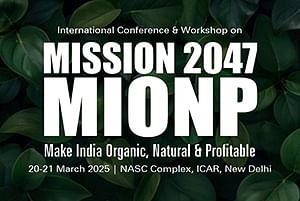
The International Forum for Environment, Sustainability, and Technology (iFOREST), a prominent environmental think tank, released a significant report on the Urea sector today on July 30, 2024. The report titled ‘Green Urea: Economic and Environmental Benefits of a Low-Carbon Future’ was released at a multistakeholder meeting, which brought together a diverse group of stakeholders— government officials, industry leaders, researchers, civil society groups, agricultural and energy experts, among others. The report is the first comprehensive modelling study on modernizing urea production and optimizing urea consumption in the country.
The report was released at the inaugural function, which was attended by Ajay Yadav, Joint Secretary, Ministry of New and Renewable Energy (MNRE), Siba Prasad Mohanty, Managing Director, Hindustan Urvarak & Rasayan Limited, R.K. Chopra, Kribhco Fertilizers Ltd., and Vineet Mittal, Chairman, Avaada Group.
Speaking at the inaugural session, Dr Chandra Bhushan, President and CEO of iFOREST, said, "Decarbonising Urea manufacturing and optimizing consumption is key to building resilience and enhancing the productivity of Indian agriculture. On the one hand, Urea consumption has reached unsustainable proportions, putting a question mark on food security. On the other, the Urea sector is now largely dependent on imported natural gas, thereby putting a question mark on energy security. By adopting a Green Urea Mission, India can enhance food and energy security, reduce subsidy and environmental costs, and support small farmers. The net benefit of a Green Urea Mission is close to a trillion dollars in the next 25 years.”
Speaking at the event, R.K. Chopra, Kribhco Fertilizers Ltd., said, "There are challenges in moving towards green urea currently, including the higher cost of technology and capital investment. However, with a proper government policy to promote green urea, some of these challenges can be mitigated.”
Siba Prasad Mohanty, MD of HURL, said, “The fertiliser industry is very keen to contribute towards the net zero goal and to optimize urea consumption. We understand the environmental impact and are keen to support government efforts towards decarbonization. While the costs are higher today, with proper policy support, green urea can be made competitive in the future.”
Key Findings:
The report has comprehensively modelled Urea demand from 2025 to 2050 using six scenarios. It has also modelled all 36 existing plants to identify the optimal technology route to produce Urea cost-effectively until 2050. Finally, the demand-side and supply-side modelling results are combined to develop a Low-Carbon Pathway for the Urea sector in India.
Demand Optimization:
-
Urea accounts for 80% of nitrogenous fertilizer and contributes 21.7% of greenhouse gas (GHG) emissions from the agricultural sector.
-
Urea consumption has reached unsustainable proportions, putting a question mark on food security. In 2022-23, the average ratio of NPK fertilizer use in India was 11.8:4.6:1, compared to the recommended ratio of 4:2:1.
-
The Urea subsidy has skyrocketed, increasing 340 times since 1980 -81.
-
With a nitrogen use efficiency of less than 35%, two-thirds of the Urea applied to fields is lost to the environment, causing air and water pollution and land degradation.
-
The cost of water pollution due to Urea use is estimated at $30 billion, more than the turnover of the Urea industry.
-
Urea consumption in India can be halved in the next 25 years—from 36 million tonnes presently to 18 million tonnes in 2050—by strengthening existing policies such as promoting natural farming, enhancing nitrogen use efficiency, and reducing the proportion of Urea in nitrogenous fertilizers.
Supply Decarbonization:
-
The average age of Urea plants in India is nearly 30 years, with 45% of the plants over 40 years old. The older plants continue to operate with Renovation and Modernization (R&M).
-
The Urea sector is highly dependent on imports. In 2022-23, 84% of Urea was produced from imported natural gas, and about 21% of Urea was imported.
-
iFOREST’s modelling shows that the cheapest method to produce Urea from 2030 onwards is through the Green Urea route, using Green Hydrogen. However, R&M is the most expensive way to produce Urea.
-
The modelling results also show that through a progressive plan, all the existing plants in Urea can be transitioned to Green Urea between 2030 -2050.
-
Despite being the second-largest consumer of hydrogen after oil refineries, the Urea sector is not a priority sector in the National Green Hydrogen Mission.
-
iFOREST recommends that the Urea sector be prioritized in the National Green Hydrogen Mission to transition the sector to Green Urea by 2050.
A Call for a Green Urea Mission:
-
The report calls for a Green Urea Mission, integrated with India's National Green Hydrogen Mission, to transition the Urea manufacturing sector to Green Urea by 2050. The mission should also have a 30:30:30 target for 2050:
-
Increasing the area under non-chemical farming to 30%.
-
Improving nitrogen use efficiency by 30%.
-
Reducing the proportion of Urea in nitrogenous fertilizers by 30%.
-
If the Green Urea Mission is adopted, Urea consumption can be halved by 2050, imports will be eliminated, subsidies will be reduced by 65%, GHG emissions decline by 64%, and water and air pollution can be significantly mitigated. Additionally, both energy and food security will be enhanced. The economic and environmental benefits of the Green Urea Mission are estimated to be about 1.0 trillion dollars in the next 25 years.
-
iFOREST's report advocates for the decontrol of the Urea sector to foster innovation and modernize Urea manufacturing plants to meet the Net Zero target. By integrating the Green Urea Mission with India's National Green Hydrogen Mission, a sustainable and resilient Urea sector can be built.

















